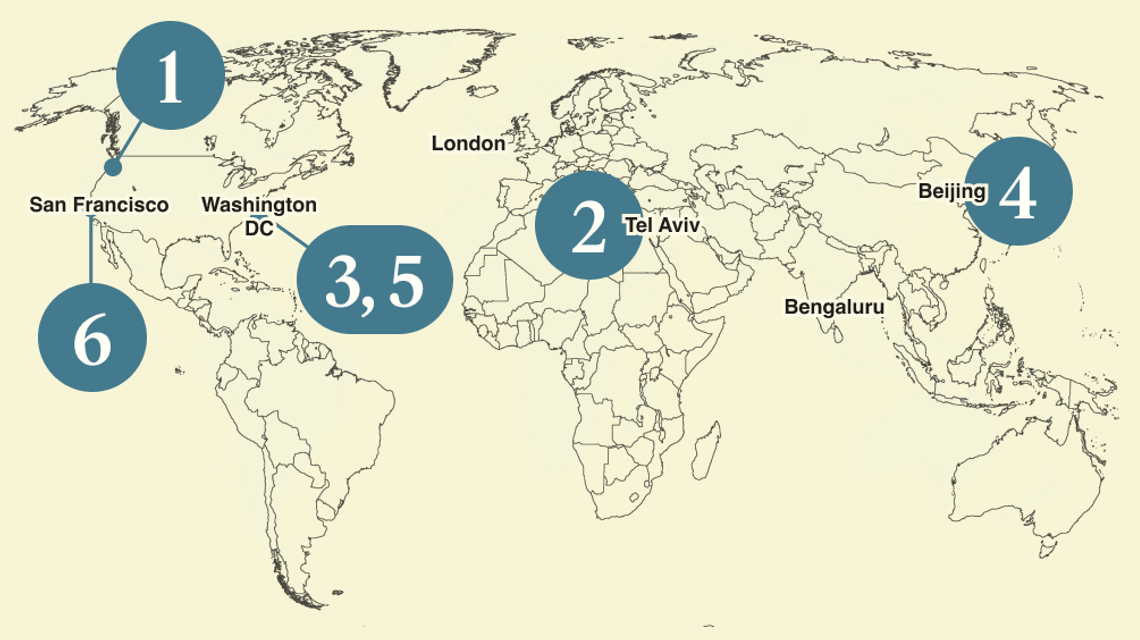| | In this edition, the battle over who regulates AI has reignited, and a startup in search of helium l͏ ͏ ͏ ͏ ͏ ͏ |
| |  | Technology |  |
| |
|
 - Cold is the new hot
- Helping machines remember
- Music, AI sync up
- Missing chips
- Deepmind’s robotics hire
- It’s bananas
 The divisive question of who gets to shape the future of AI policy, and UK college students confront a professor over AI coursework. |
|
 Our scoop that the White House is considering an executive order aimed at preventing states from regulating artificial intelligence if Congress won’t do it set off a firestorm of debate over both the substance of the move and presidential power. The question of who gets to shape the AI future is deeply divisive. But when it comes to concerns over AI, the people I talk to on all sides — inside AI startups, big tech companies, venture capital firms, etc. — are less ideologically divided than you’d expect. Virtually all want norms built around the technology, whether that comes from regulation or industry standards bodies, or both. But politics, these days, polarizes everything: You’ll hear that the big “AI companies” want to harm children, while the “doomers” want to destroy innovation. Those are unhelpful caricatures. What is true is that regulating new technology is incredibly difficult. Section 230, as well as the DMCA, COPPA, and GDPR, are all deeply flawed. State-level regulation could be worse. But it’s hard to believe that the only alternative is presidential fiat. And a note: Don’t miss Rachyl’s “cool” story below about the growing business of making things very, very cold. |
|
All the hottest tech is cold |
 Image rendering courtesy of Interlune Image rendering courtesy of InterluneFrom AI to quantum computing, the latest tech breakthroughs share one necessity: The infrastructure around them must be cold. Finding new ways to chill devices and keep them at low temperatures is emerging as a key engineering frontier — and a big business, Semafor’s Rachyl Jones reports. One plan, from startup Interlune, is to fly rockets to the moon, use robots to capture a rare isotope of helium from moon rocks, and use the gas to cool quantum computers, according to the company’s CEO Rob Meyerson, who says it has signed $500 million in contracts so far. “The moon is for all of us,” said the former president of the Jeff Bezos space venture Blue Origin. As Russia and big quantum competitor China make moves to develop on the moon and extract lunar resources, “it’s important that we — the West, the US, Interlune — establish a right to operate on the moon.” AI technologies are growing rapidly, and quantum computers are primed to take off in the coming years, catapulting demand for the components that make them work. Some forms of nuclear fusion, the energy source touted by tech leaders as the future of power, also rely on cooled superconducting magnets. Data-center servers that power AI heat up when processing complex workloads, and that heat can slow them down, or shut them off entirely. The potential of AI to reshape society, as industry leaders are promising, depends in part on these cooling mechanisms, as does the basic function of another red-hot emerging technology: quantum computers. |
|
Majestic Labs CEO on tackling AI’s memory |
 Semafor’s Reed Albergotti (L) and Majestic Labs’ Ofer Shacham. Semafor/YouTube. Semafor’s Reed Albergotti (L) and Majestic Labs’ Ofer Shacham. Semafor/YouTube.Moore’s law died a long time ago. Instead of making transistors and circuits smaller, we’ve just added more and more circuits and transistors by linking chips together. And that’s why we now have AI compute clusters with a million chips. But there’s another bottleneck that the tech industry hasn’t quite figured out: memory. One startup offering a solution is Majestic Labs, which is building a new kind of AI chip centered around memory bandwidth. Semafor spoke with co-founder and CEO Ofer Shacham about AI’s memory problem. Listen and watch the full interview on our YouTube channel. |
|
Music studios and AI startups find harmony |
 wundervisuals/Getty wundervisuals/GettyIf you can’t beat them, join them. Studio powerhouses Warner Music Group, Universal Music Group, and Sony Music Entertainment signed a licensing agreement with AI music startup Klay Vision to provide their music catalogs as training material for the startup’s song-generation engine, the companies announced Thursday. WMG and UMG also have licensing agreements with music startup Udio — both of which began as lawsuits — but Klay is the first to publicly announce partnerships with all of the Big Three. Suno, another popular song-generation platform, is still wrapped up in lawsuits and hasn’t yet reached licensing agreements with the studios. Music is just one industry turning to licensing deals to settle its long, embattled copyright disputes with AI companies. Content creators are inking deals to license their stockpile of old videos to train video-generation models. “Go take your money, girl,” one creator told me. The phenomenon represents a widespread realization that it’s easier, and more lucrative, to join powerful and well-funded AI firms rather than fight the future norm. — Rachyl Jones |
|
Chip-smuggling case highlights trade tensions |
 Evelyn Hockstein/Reuters Evelyn Hockstein/ReutersFederal prosecutors in California indicted two Americans and two Chinese citizens for allegedly trying to smuggle HPE supercomputers and hundreds of Nvidia chips into mainland China, amounting to roughly $3.9 million in transactions. The indictment, initially reported by Court Watch on Wednesday, came out at roughly the same time that Nvidia released earnings. (Buried in those earnings was a tweak that makes it harder to see where its chips are sent.) The chips may not be hiding in live lobsters (remember that?), but the charges are a fresh reminder that efforts to bypass US export controls are ongoing as demand remains high for the US’ top chips, even as China builds up its domestic semiconductor industry. Separately, the US Justice Department in August accused two Chinese citizens of shipping sensitive GPUs and other computing parts to China. However, the latest indictment, which outlines the transfer of 10 supercomputers, highlights a particularly brazen approach. It also puts a renewed focus on Thailand and Malaysia, where the defendants allegedly trafficked the devices through. |
|
DeepMind hires Boston Dynamics CTO |
 DeepMind’s Demis Hassabis. Toby Melville/Reuters. DeepMind’s Demis Hassabis. Toby Melville/Reuters.Google DeepMind hired the former CTO of Boston Dynamics, Aaron Saunders, as part of an attempt to push forward with robotics. Whereas AI has made rapid progress in recent years, advancements in robots have been less evident: In 2021, DeepMind’s robotics chief said the field lagged the rest of AI by 10 years. Partly, it’s a data problem. An AI dedicated to chess can download millions of games to study; robots, too, can train in simulation, but such “sim-to-real” training can work brilliantly in the virtual world and then fall apart in reality. Progress is slow, and robots still cannot reliably perform basic household tasks. DeepMind’s Demis Hassabis wants to fix that, and to use his company’s multimodal Gemini model as a sort of operating system. His new hire’s former company — which was bought by Google in 2013 before being sold in 2017 — has developed some of the most advanced legged robots, and Hassabis told WIRED that AI-powered robotics “is going to have its breakthrough moment in the next couple of years.” The race isn’t constrained to the West, however: China’s robotics industry saw its revenue surge nearly 30% year-on-year in the first nine months of 2025, with companies producing some 14 million robots so far this year, according to the Chinese business-focused magazine Caixin. |
|
New Nano Banana version has one ripened update |
| |  | Reed Albergotti |
| |
 A list of cocktails made using Nano Banana. Reed Albergotti/Semafor. A list of cocktails made using Nano Banana. Reed Albergotti/Semafor.Google updated its Nano Banana image generator Thursday, powered by the Gemini 3 model it released a couple of days prior. It’s sometimes difficult to tell the difference between model releases because the improvements are incremental, at least year-to-year. But the new image generator has one key improvement I noticed right away: Text. I used the previous Nano Banana version over the weekend to create a “signature cocktail list” for my wife’s karaoke birthday party. I wanted it to look like an old-school wood cut concert poster and I created a fake band name for my wife and her friend, who was co-hosting the party. The posters it created were spectacular, but it misspelled words like “explanatory,” “fashioned,” and even “Riviera.” It took me many tries to get it right, even if it did still mess up the hands. When I pasted the same prompt into the updated Nano Banana Thursday, it spelled every word perfectly on the first try. It’s still not perfect, and stumbled when I asked it to create an image of the typeset used to print the text of the United States Constitution, a bit of a daunting task because the letters need to be backwards. But this kind of improvement shows the model has a greater “understanding” of the images it’s creating. And that is actually a bigger leap forward than just making images look nicer or more realistic. It makes it a more useful tool. |
|
 Can the Supreme Court keep its secrets? New York Times investigative reporter Jodi Kantor joins Mixed Signals to explain how she’s revealed the secrets of internal deliberations behind the ceremony and black robes of the US Supreme Court. Max and Ben ask whether the court is actually leaking more, how newer justices are reshaping its public face, and what Kantor has learned about the culture of secrecy and power inside a long impenetrable institution. She also reflects on the post–#MeToo media landscape and the fracturing of “factual consensus.” Listen to the latest episode on Mixed Signals now. |
|
 A student on the Staffordshire University campus. Nathan Stirk/Getty Images. A student on the Staffordshire University campus. Nathan Stirk/Getty Images.Students at the University of Staffordshire in England are raising concerns over coursework they say is AI-generated, the Guardian reported. Materials for a coding class contained presentation slides that appeared |
|
|